Evaluating Traditional Interview Process in Human Resource Management
VerifiedAdded on 2021/05/29
|11
|3347
|22
Report
AI Summary
This report critically evaluates the effectiveness of traditional interviews in human resource management (HRM) for candidate selection. It begins by outlining the crucial role of HRM in organizations, particularly in recruitment and selection processes. The report then delves into the traditional interview process, contrasting it with structured interviews and highlighting its advantages, such as cost-effectiveness and the ability to build rapport. However, the core of the report focuses on the limitations and biases inherent in traditional interviews, including expectancy effects, primacy effects, contrast effects, quota effects, and similar-to-me effects. These biases can compromise the reliability and validity of the selection process. The report emphasizes the importance of interviewer skills and preparation, concluding that while traditional interviews have their place, they are often less effective than structured approaches. The report also examines the importance of face-to-face interactions and the need for interviewers to possess specific skills. The report underscores that a structured interview approach is often more effective and consistent in the selection of suitable candidates.

1
Paraphrase This Document
Need a fresh take? Get an instant paraphrase of this document with our AI Paraphraser
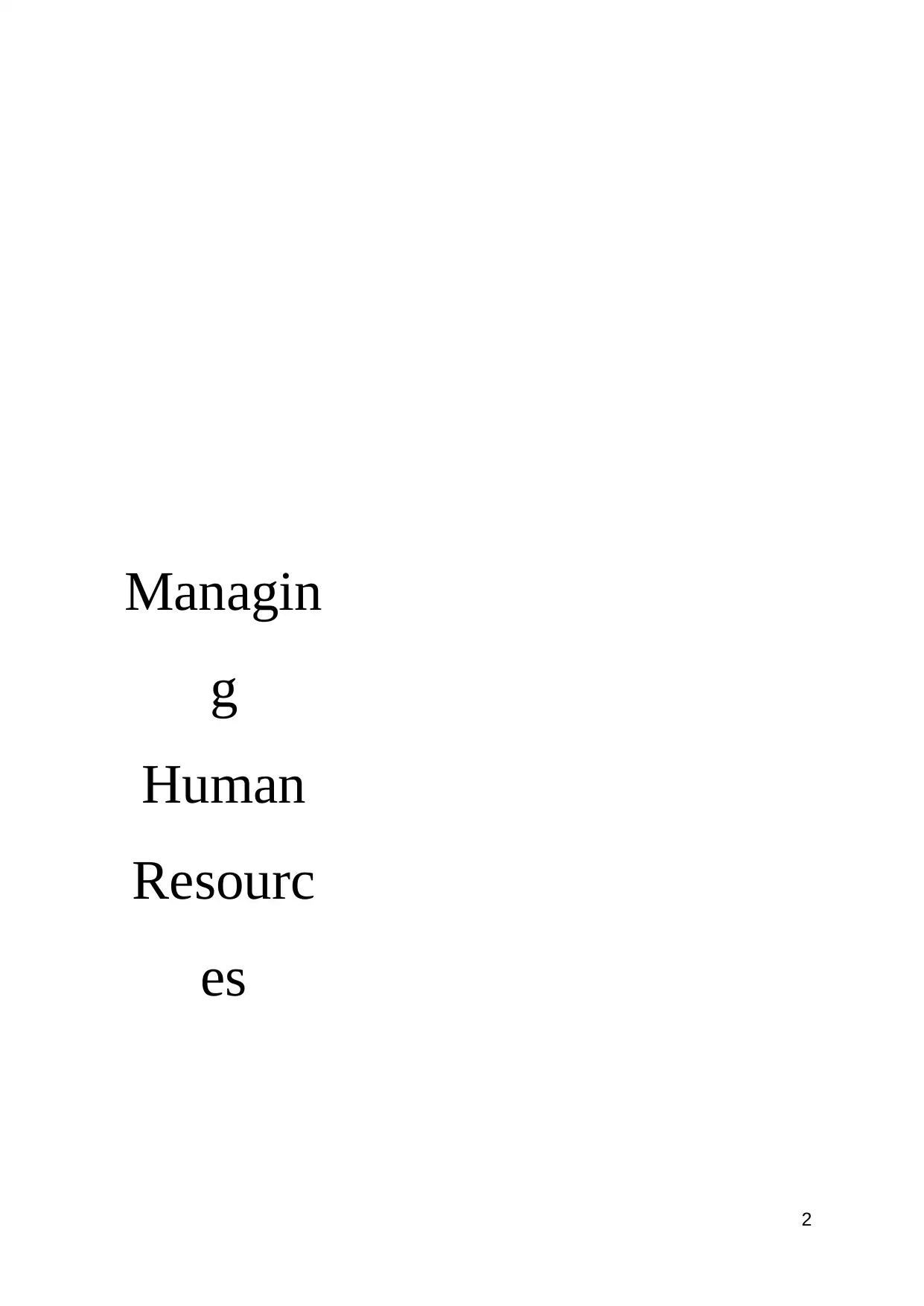
2
Managin
g
Human
Resourc
es
Managin
g
Human
Resourc
es
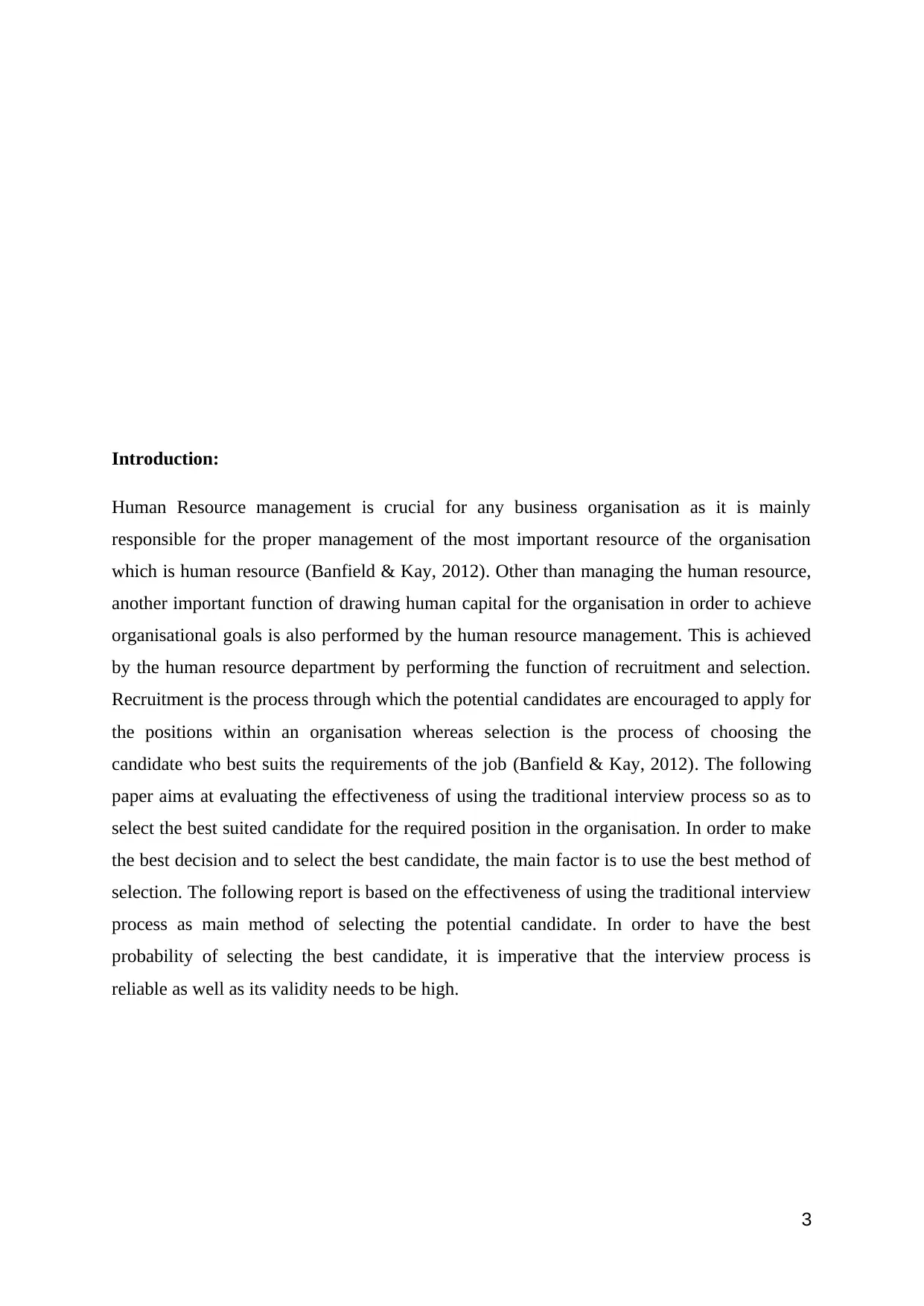
Introduction:
Human Resource management is crucial for any business organisation as it is mainly
responsible for the proper management of the most important resource of the organisation
which is human resource (Banfield & Kay, 2012). Other than managing the human resource,
another important function of drawing human capital for the organisation in order to achieve
organisational goals is also performed by the human resource management. This is achieved
by the human resource department by performing the function of recruitment and selection.
Recruitment is the process through which the potential candidates are encouraged to apply for
the positions within an organisation whereas selection is the process of choosing the
candidate who best suits the requirements of the job (Banfield & Kay, 2012). The following
paper aims at evaluating the effectiveness of using the traditional interview process so as to
select the best suited candidate for the required position in the organisation. In order to make
the best decision and to select the best candidate, the main factor is to use the best method of
selection. The following report is based on the effectiveness of using the traditional interview
process as main method of selecting the potential candidate. In order to have the best
probability of selecting the best candidate, it is imperative that the interview process is
reliable as well as its validity needs to be high.
3
Human Resource management is crucial for any business organisation as it is mainly
responsible for the proper management of the most important resource of the organisation
which is human resource (Banfield & Kay, 2012). Other than managing the human resource,
another important function of drawing human capital for the organisation in order to achieve
organisational goals is also performed by the human resource management. This is achieved
by the human resource department by performing the function of recruitment and selection.
Recruitment is the process through which the potential candidates are encouraged to apply for
the positions within an organisation whereas selection is the process of choosing the
candidate who best suits the requirements of the job (Banfield & Kay, 2012). The following
paper aims at evaluating the effectiveness of using the traditional interview process so as to
select the best suited candidate for the required position in the organisation. In order to make
the best decision and to select the best candidate, the main factor is to use the best method of
selection. The following report is based on the effectiveness of using the traditional interview
process as main method of selecting the potential candidate. In order to have the best
probability of selecting the best candidate, it is imperative that the interview process is
reliable as well as its validity needs to be high.
3
⊘ This is a preview!⊘
Do you want full access?
Subscribe today to unlock all pages.

Trusted by 1+ million students worldwide
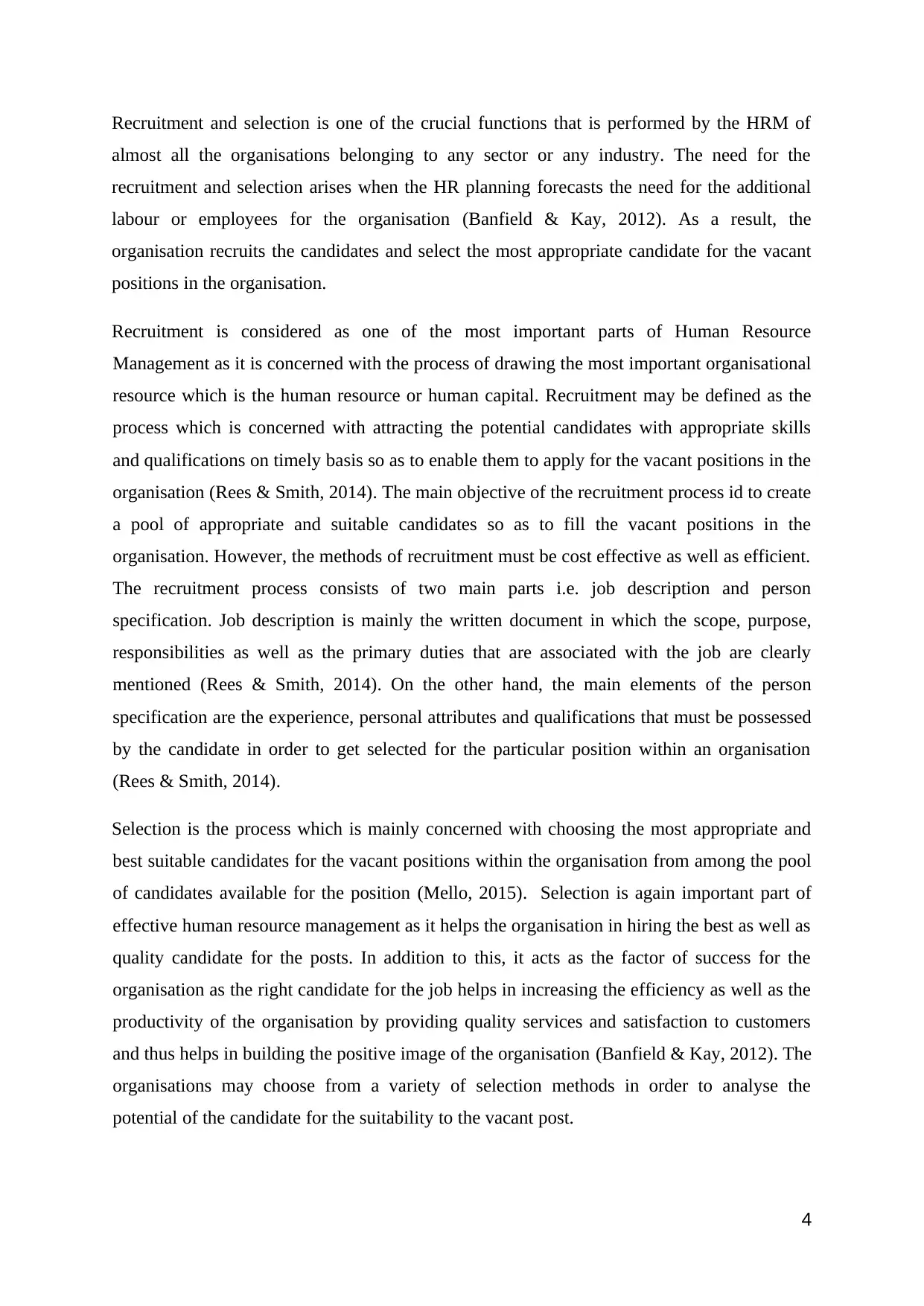
Recruitment and selection is one of the crucial functions that is performed by the HRM of
almost all the organisations belonging to any sector or any industry. The need for the
recruitment and selection arises when the HR planning forecasts the need for the additional
labour or employees for the organisation (Banfield & Kay, 2012). As a result, the
organisation recruits the candidates and select the most appropriate candidate for the vacant
positions in the organisation.
Recruitment is considered as one of the most important parts of Human Resource
Management as it is concerned with the process of drawing the most important organisational
resource which is the human resource or human capital. Recruitment may be defined as the
process which is concerned with attracting the potential candidates with appropriate skills
and qualifications on timely basis so as to enable them to apply for the vacant positions in the
organisation (Rees & Smith, 2014). The main objective of the recruitment process id to create
a pool of appropriate and suitable candidates so as to fill the vacant positions in the
organisation. However, the methods of recruitment must be cost effective as well as efficient.
The recruitment process consists of two main parts i.e. job description and person
specification. Job description is mainly the written document in which the scope, purpose,
responsibilities as well as the primary duties that are associated with the job are clearly
mentioned (Rees & Smith, 2014). On the other hand, the main elements of the person
specification are the experience, personal attributes and qualifications that must be possessed
by the candidate in order to get selected for the particular position within an organisation
(Rees & Smith, 2014).
Selection is the process which is mainly concerned with choosing the most appropriate and
best suitable candidates for the vacant positions within the organisation from among the pool
of candidates available for the position (Mello, 2015). Selection is again important part of
effective human resource management as it helps the organisation in hiring the best as well as
quality candidate for the posts. In addition to this, it acts as the factor of success for the
organisation as the right candidate for the job helps in increasing the efficiency as well as the
productivity of the organisation by providing quality services and satisfaction to customers
and thus helps in building the positive image of the organisation (Banfield & Kay, 2012). The
organisations may choose from a variety of selection methods in order to analyse the
potential of the candidate for the suitability to the vacant post.
4
almost all the organisations belonging to any sector or any industry. The need for the
recruitment and selection arises when the HR planning forecasts the need for the additional
labour or employees for the organisation (Banfield & Kay, 2012). As a result, the
organisation recruits the candidates and select the most appropriate candidate for the vacant
positions in the organisation.
Recruitment is considered as one of the most important parts of Human Resource
Management as it is concerned with the process of drawing the most important organisational
resource which is the human resource or human capital. Recruitment may be defined as the
process which is concerned with attracting the potential candidates with appropriate skills
and qualifications on timely basis so as to enable them to apply for the vacant positions in the
organisation (Rees & Smith, 2014). The main objective of the recruitment process id to create
a pool of appropriate and suitable candidates so as to fill the vacant positions in the
organisation. However, the methods of recruitment must be cost effective as well as efficient.
The recruitment process consists of two main parts i.e. job description and person
specification. Job description is mainly the written document in which the scope, purpose,
responsibilities as well as the primary duties that are associated with the job are clearly
mentioned (Rees & Smith, 2014). On the other hand, the main elements of the person
specification are the experience, personal attributes and qualifications that must be possessed
by the candidate in order to get selected for the particular position within an organisation
(Rees & Smith, 2014).
Selection is the process which is mainly concerned with choosing the most appropriate and
best suitable candidates for the vacant positions within the organisation from among the pool
of candidates available for the position (Mello, 2015). Selection is again important part of
effective human resource management as it helps the organisation in hiring the best as well as
quality candidate for the posts. In addition to this, it acts as the factor of success for the
organisation as the right candidate for the job helps in increasing the efficiency as well as the
productivity of the organisation by providing quality services and satisfaction to customers
and thus helps in building the positive image of the organisation (Banfield & Kay, 2012). The
organisations may choose from a variety of selection methods in order to analyse the
potential of the candidate for the suitability to the vacant post.
4
Paraphrase This Document
Need a fresh take? Get an instant paraphrase of this document with our AI Paraphraser
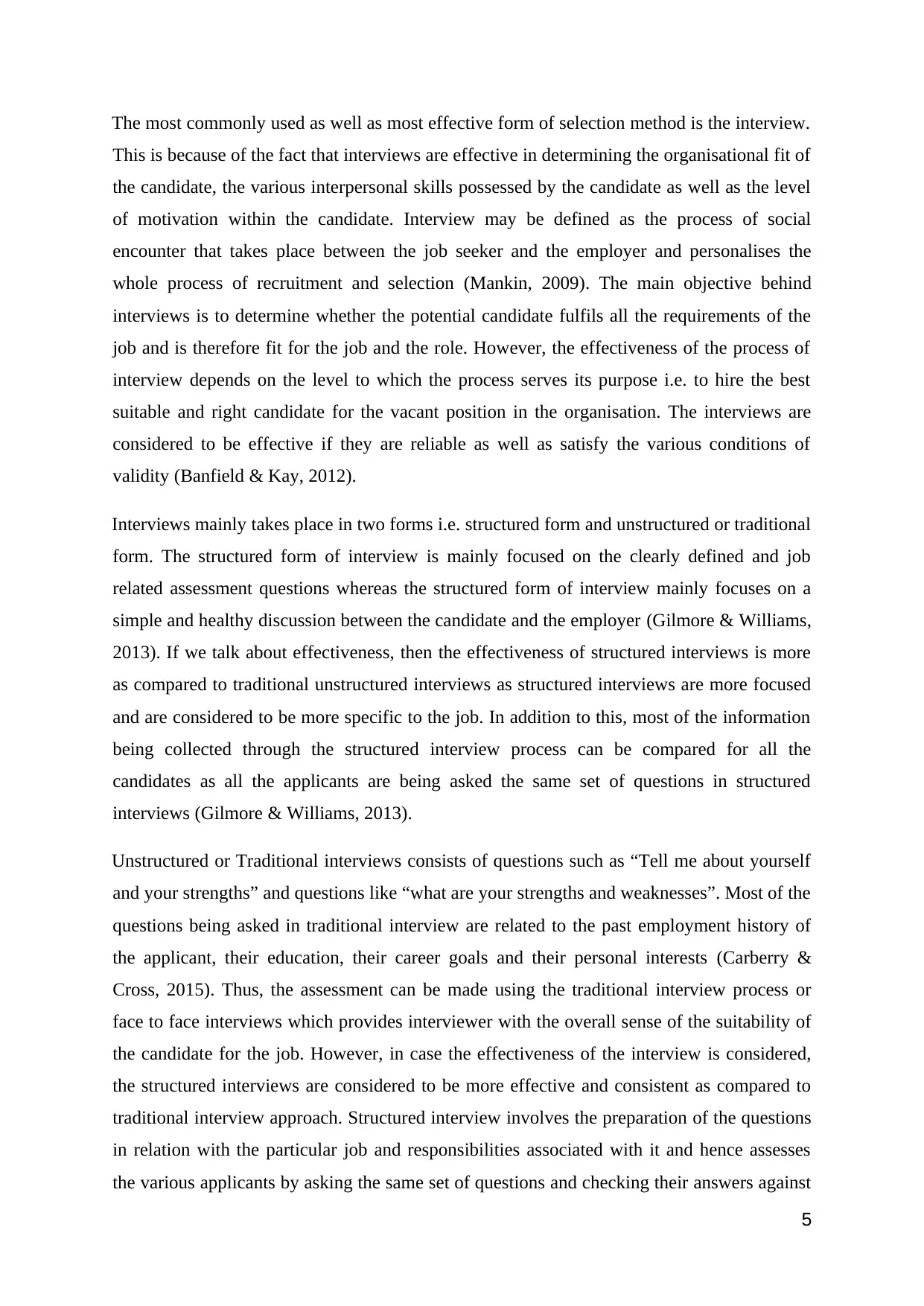
The most commonly used as well as most effective form of selection method is the interview.
This is because of the fact that interviews are effective in determining the organisational fit of
the candidate, the various interpersonal skills possessed by the candidate as well as the level
of motivation within the candidate. Interview may be defined as the process of social
encounter that takes place between the job seeker and the employer and personalises the
whole process of recruitment and selection (Mankin, 2009). The main objective behind
interviews is to determine whether the potential candidate fulfils all the requirements of the
job and is therefore fit for the job and the role. However, the effectiveness of the process of
interview depends on the level to which the process serves its purpose i.e. to hire the best
suitable and right candidate for the vacant position in the organisation. The interviews are
considered to be effective if they are reliable as well as satisfy the various conditions of
validity (Banfield & Kay, 2012).
Interviews mainly takes place in two forms i.e. structured form and unstructured or traditional
form. The structured form of interview is mainly focused on the clearly defined and job
related assessment questions whereas the structured form of interview mainly focuses on a
simple and healthy discussion between the candidate and the employer (Gilmore & Williams,
2013). If we talk about effectiveness, then the effectiveness of structured interviews is more
as compared to traditional unstructured interviews as structured interviews are more focused
and are considered to be more specific to the job. In addition to this, most of the information
being collected through the structured interview process can be compared for all the
candidates as all the applicants are being asked the same set of questions in structured
interviews (Gilmore & Williams, 2013).
Unstructured or Traditional interviews consists of questions such as “Tell me about yourself
and your strengths” and questions like “what are your strengths and weaknesses”. Most of the
questions being asked in traditional interview are related to the past employment history of
the applicant, their education, their career goals and their personal interests (Carberry &
Cross, 2015). Thus, the assessment can be made using the traditional interview process or
face to face interviews which provides interviewer with the overall sense of the suitability of
the candidate for the job. However, in case the effectiveness of the interview is considered,
the structured interviews are considered to be more effective and consistent as compared to
traditional interview approach. Structured interview involves the preparation of the questions
in relation with the particular job and responsibilities associated with it and hence assesses
the various applicants by asking the same set of questions and checking their answers against
5
This is because of the fact that interviews are effective in determining the organisational fit of
the candidate, the various interpersonal skills possessed by the candidate as well as the level
of motivation within the candidate. Interview may be defined as the process of social
encounter that takes place between the job seeker and the employer and personalises the
whole process of recruitment and selection (Mankin, 2009). The main objective behind
interviews is to determine whether the potential candidate fulfils all the requirements of the
job and is therefore fit for the job and the role. However, the effectiveness of the process of
interview depends on the level to which the process serves its purpose i.e. to hire the best
suitable and right candidate for the vacant position in the organisation. The interviews are
considered to be effective if they are reliable as well as satisfy the various conditions of
validity (Banfield & Kay, 2012).
Interviews mainly takes place in two forms i.e. structured form and unstructured or traditional
form. The structured form of interview is mainly focused on the clearly defined and job
related assessment questions whereas the structured form of interview mainly focuses on a
simple and healthy discussion between the candidate and the employer (Gilmore & Williams,
2013). If we talk about effectiveness, then the effectiveness of structured interviews is more
as compared to traditional unstructured interviews as structured interviews are more focused
and are considered to be more specific to the job. In addition to this, most of the information
being collected through the structured interview process can be compared for all the
candidates as all the applicants are being asked the same set of questions in structured
interviews (Gilmore & Williams, 2013).
Unstructured or Traditional interviews consists of questions such as “Tell me about yourself
and your strengths” and questions like “what are your strengths and weaknesses”. Most of the
questions being asked in traditional interview are related to the past employment history of
the applicant, their education, their career goals and their personal interests (Carberry &
Cross, 2015). Thus, the assessment can be made using the traditional interview process or
face to face interviews which provides interviewer with the overall sense of the suitability of
the candidate for the job. However, in case the effectiveness of the interview is considered,
the structured interviews are considered to be more effective and consistent as compared to
traditional interview approach. Structured interview involves the preparation of the questions
in relation with the particular job and responsibilities associated with it and hence assesses
the various applicants by asking the same set of questions and checking their answers against
5
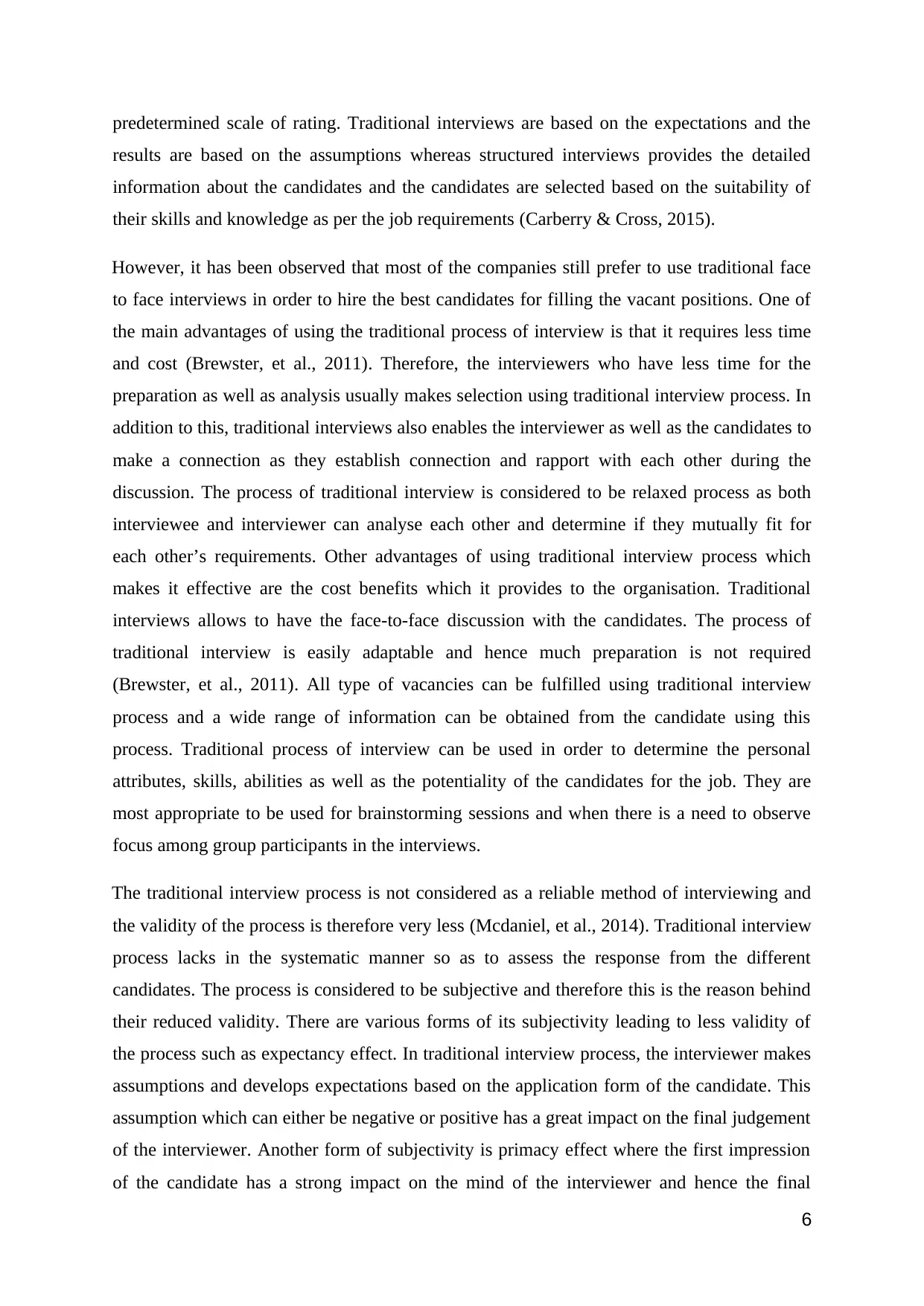
predetermined scale of rating. Traditional interviews are based on the expectations and the
results are based on the assumptions whereas structured interviews provides the detailed
information about the candidates and the candidates are selected based on the suitability of
their skills and knowledge as per the job requirements (Carberry & Cross, 2015).
However, it has been observed that most of the companies still prefer to use traditional face
to face interviews in order to hire the best candidates for filling the vacant positions. One of
the main advantages of using the traditional process of interview is that it requires less time
and cost (Brewster, et al., 2011). Therefore, the interviewers who have less time for the
preparation as well as analysis usually makes selection using traditional interview process. In
addition to this, traditional interviews also enables the interviewer as well as the candidates to
make a connection as they establish connection and rapport with each other during the
discussion. The process of traditional interview is considered to be relaxed process as both
interviewee and interviewer can analyse each other and determine if they mutually fit for
each other’s requirements. Other advantages of using traditional interview process which
makes it effective are the cost benefits which it provides to the organisation. Traditional
interviews allows to have the face-to-face discussion with the candidates. The process of
traditional interview is easily adaptable and hence much preparation is not required
(Brewster, et al., 2011). All type of vacancies can be fulfilled using traditional interview
process and a wide range of information can be obtained from the candidate using this
process. Traditional process of interview can be used in order to determine the personal
attributes, skills, abilities as well as the potentiality of the candidates for the job. They are
most appropriate to be used for brainstorming sessions and when there is a need to observe
focus among group participants in the interviews.
The traditional interview process is not considered as a reliable method of interviewing and
the validity of the process is therefore very less (Mcdaniel, et al., 2014). Traditional interview
process lacks in the systematic manner so as to assess the response from the different
candidates. The process is considered to be subjective and therefore this is the reason behind
their reduced validity. There are various forms of its subjectivity leading to less validity of
the process such as expectancy effect. In traditional interview process, the interviewer makes
assumptions and develops expectations based on the application form of the candidate. This
assumption which can either be negative or positive has a great impact on the final judgement
of the interviewer. Another form of subjectivity is primacy effect where the first impression
of the candidate has a strong impact on the mind of the interviewer and hence the final
6
results are based on the assumptions whereas structured interviews provides the detailed
information about the candidates and the candidates are selected based on the suitability of
their skills and knowledge as per the job requirements (Carberry & Cross, 2015).
However, it has been observed that most of the companies still prefer to use traditional face
to face interviews in order to hire the best candidates for filling the vacant positions. One of
the main advantages of using the traditional process of interview is that it requires less time
and cost (Brewster, et al., 2011). Therefore, the interviewers who have less time for the
preparation as well as analysis usually makes selection using traditional interview process. In
addition to this, traditional interviews also enables the interviewer as well as the candidates to
make a connection as they establish connection and rapport with each other during the
discussion. The process of traditional interview is considered to be relaxed process as both
interviewee and interviewer can analyse each other and determine if they mutually fit for
each other’s requirements. Other advantages of using traditional interview process which
makes it effective are the cost benefits which it provides to the organisation. Traditional
interviews allows to have the face-to-face discussion with the candidates. The process of
traditional interview is easily adaptable and hence much preparation is not required
(Brewster, et al., 2011). All type of vacancies can be fulfilled using traditional interview
process and a wide range of information can be obtained from the candidate using this
process. Traditional process of interview can be used in order to determine the personal
attributes, skills, abilities as well as the potentiality of the candidates for the job. They are
most appropriate to be used for brainstorming sessions and when there is a need to observe
focus among group participants in the interviews.
The traditional interview process is not considered as a reliable method of interviewing and
the validity of the process is therefore very less (Mcdaniel, et al., 2014). Traditional interview
process lacks in the systematic manner so as to assess the response from the different
candidates. The process is considered to be subjective and therefore this is the reason behind
their reduced validity. There are various forms of its subjectivity leading to less validity of
the process such as expectancy effect. In traditional interview process, the interviewer makes
assumptions and develops expectations based on the application form of the candidate. This
assumption which can either be negative or positive has a great impact on the final judgement
of the interviewer. Another form of subjectivity is primacy effect where the first impression
of the candidate has a strong impact on the mind of the interviewer and hence the final
6
⊘ This is a preview!⊘
Do you want full access?
Subscribe today to unlock all pages.

Trusted by 1+ million students worldwide
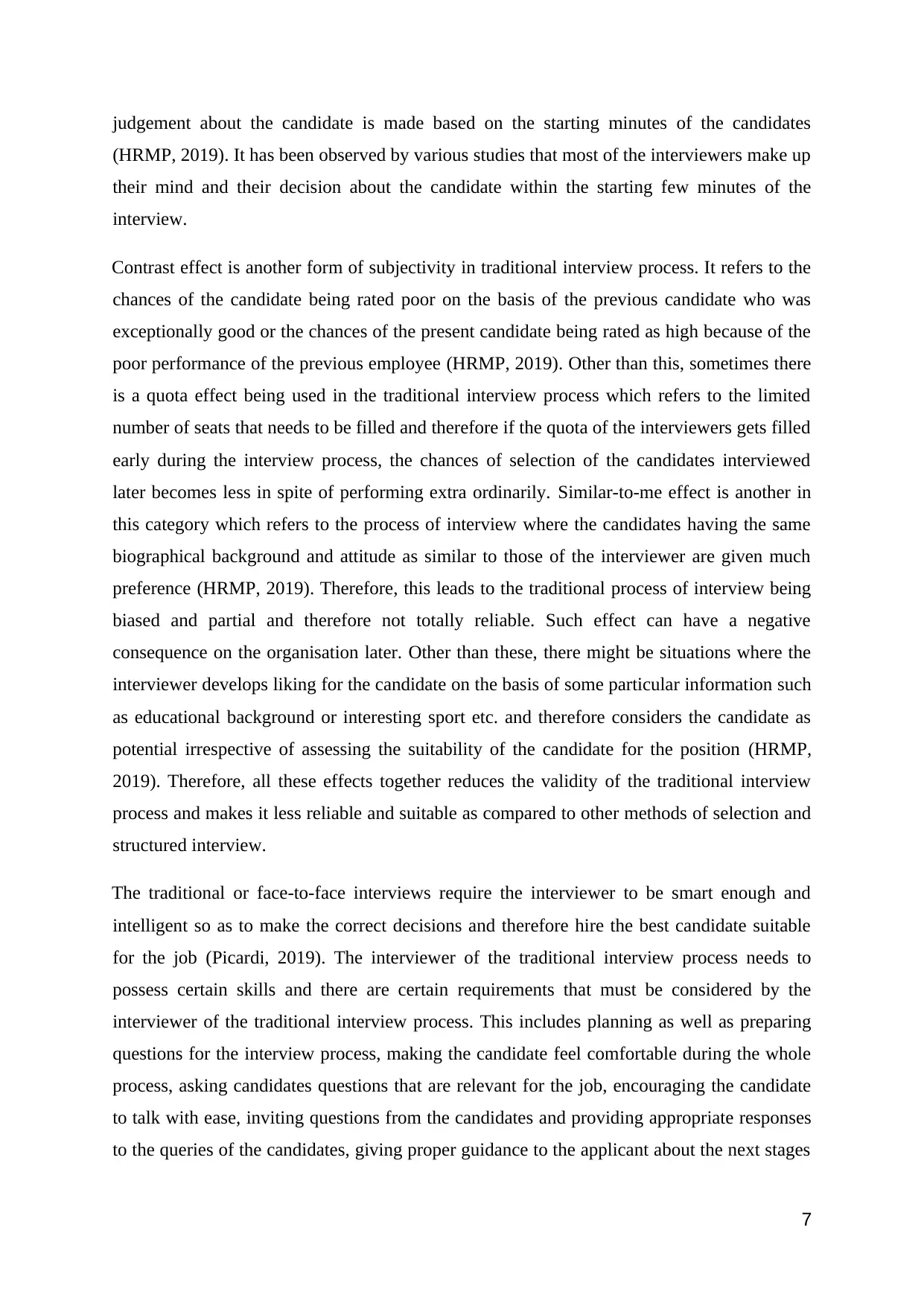
judgement about the candidate is made based on the starting minutes of the candidates
(HRMP, 2019). It has been observed by various studies that most of the interviewers make up
their mind and their decision about the candidate within the starting few minutes of the
interview.
Contrast effect is another form of subjectivity in traditional interview process. It refers to the
chances of the candidate being rated poor on the basis of the previous candidate who was
exceptionally good or the chances of the present candidate being rated as high because of the
poor performance of the previous employee (HRMP, 2019). Other than this, sometimes there
is a quota effect being used in the traditional interview process which refers to the limited
number of seats that needs to be filled and therefore if the quota of the interviewers gets filled
early during the interview process, the chances of selection of the candidates interviewed
later becomes less in spite of performing extra ordinarily. Similar-to-me effect is another in
this category which refers to the process of interview where the candidates having the same
biographical background and attitude as similar to those of the interviewer are given much
preference (HRMP, 2019). Therefore, this leads to the traditional process of interview being
biased and partial and therefore not totally reliable. Such effect can have a negative
consequence on the organisation later. Other than these, there might be situations where the
interviewer develops liking for the candidate on the basis of some particular information such
as educational background or interesting sport etc. and therefore considers the candidate as
potential irrespective of assessing the suitability of the candidate for the position (HRMP,
2019). Therefore, all these effects together reduces the validity of the traditional interview
process and makes it less reliable and suitable as compared to other methods of selection and
structured interview.
The traditional or face-to-face interviews require the interviewer to be smart enough and
intelligent so as to make the correct decisions and therefore hire the best candidate suitable
for the job (Picardi, 2019). The interviewer of the traditional interview process needs to
possess certain skills and there are certain requirements that must be considered by the
interviewer of the traditional interview process. This includes planning as well as preparing
questions for the interview process, making the candidate feel comfortable during the whole
process, asking candidates questions that are relevant for the job, encouraging the candidate
to talk with ease, inviting questions from the candidates and providing appropriate responses
to the queries of the candidates, giving proper guidance to the applicant about the next stages
7
(HRMP, 2019). It has been observed by various studies that most of the interviewers make up
their mind and their decision about the candidate within the starting few minutes of the
interview.
Contrast effect is another form of subjectivity in traditional interview process. It refers to the
chances of the candidate being rated poor on the basis of the previous candidate who was
exceptionally good or the chances of the present candidate being rated as high because of the
poor performance of the previous employee (HRMP, 2019). Other than this, sometimes there
is a quota effect being used in the traditional interview process which refers to the limited
number of seats that needs to be filled and therefore if the quota of the interviewers gets filled
early during the interview process, the chances of selection of the candidates interviewed
later becomes less in spite of performing extra ordinarily. Similar-to-me effect is another in
this category which refers to the process of interview where the candidates having the same
biographical background and attitude as similar to those of the interviewer are given much
preference (HRMP, 2019). Therefore, this leads to the traditional process of interview being
biased and partial and therefore not totally reliable. Such effect can have a negative
consequence on the organisation later. Other than these, there might be situations where the
interviewer develops liking for the candidate on the basis of some particular information such
as educational background or interesting sport etc. and therefore considers the candidate as
potential irrespective of assessing the suitability of the candidate for the position (HRMP,
2019). Therefore, all these effects together reduces the validity of the traditional interview
process and makes it less reliable and suitable as compared to other methods of selection and
structured interview.
The traditional or face-to-face interviews require the interviewer to be smart enough and
intelligent so as to make the correct decisions and therefore hire the best candidate suitable
for the job (Picardi, 2019). The interviewer of the traditional interview process needs to
possess certain skills and there are certain requirements that must be considered by the
interviewer of the traditional interview process. This includes planning as well as preparing
questions for the interview process, making the candidate feel comfortable during the whole
process, asking candidates questions that are relevant for the job, encouraging the candidate
to talk with ease, inviting questions from the candidates and providing appropriate responses
to the queries of the candidates, giving proper guidance to the applicant about the next stages
7
Paraphrase This Document
Need a fresh take? Get an instant paraphrase of this document with our AI Paraphraser
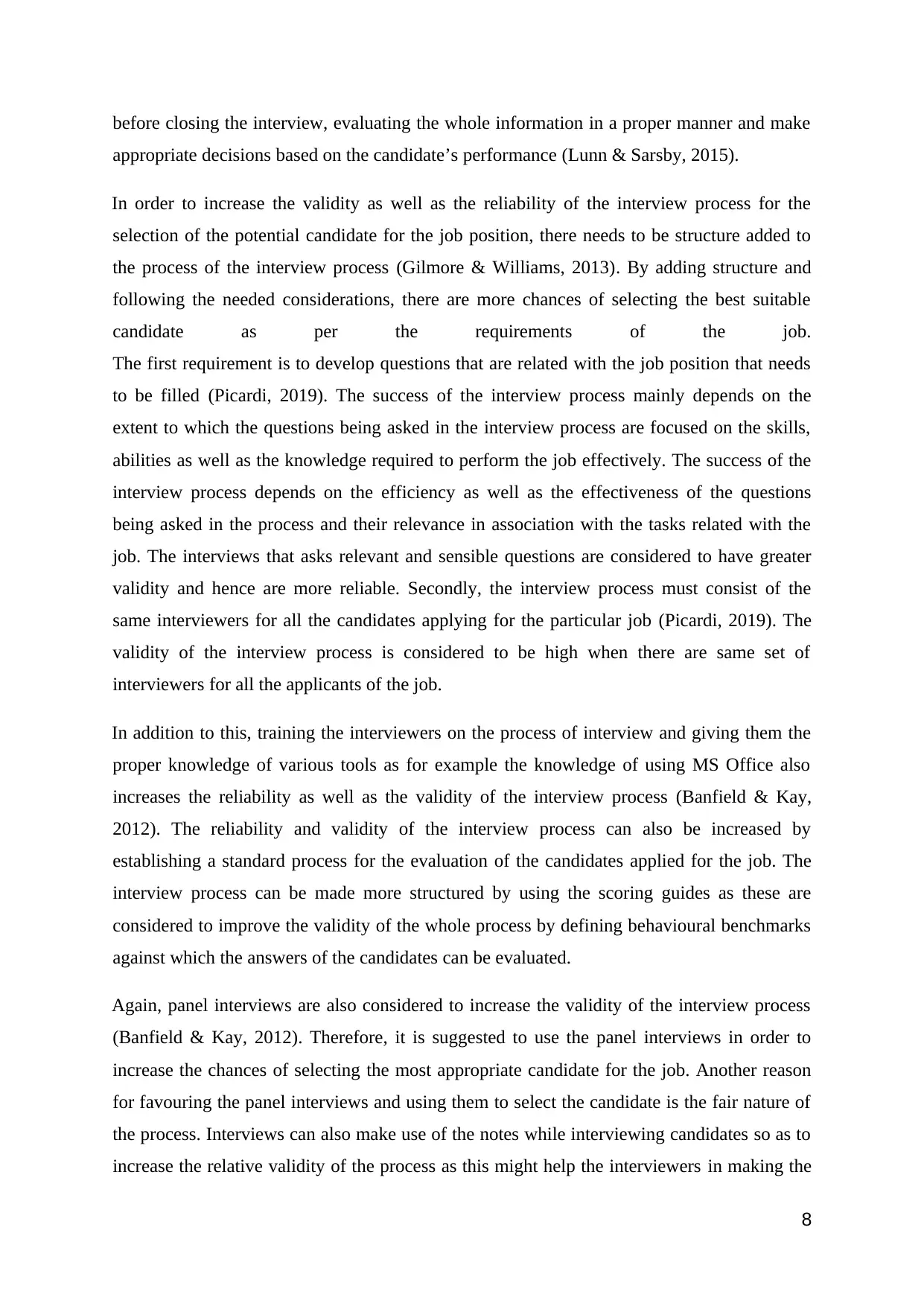
before closing the interview, evaluating the whole information in a proper manner and make
appropriate decisions based on the candidate’s performance (Lunn & Sarsby, 2015).
In order to increase the validity as well as the reliability of the interview process for the
selection of the potential candidate for the job position, there needs to be structure added to
the process of the interview process (Gilmore & Williams, 2013). By adding structure and
following the needed considerations, there are more chances of selecting the best suitable
candidate as per the requirements of the job.
The first requirement is to develop questions that are related with the job position that needs
to be filled (Picardi, 2019). The success of the interview process mainly depends on the
extent to which the questions being asked in the interview process are focused on the skills,
abilities as well as the knowledge required to perform the job effectively. The success of the
interview process depends on the efficiency as well as the effectiveness of the questions
being asked in the process and their relevance in association with the tasks related with the
job. The interviews that asks relevant and sensible questions are considered to have greater
validity and hence are more reliable. Secondly, the interview process must consist of the
same interviewers for all the candidates applying for the particular job (Picardi, 2019). The
validity of the interview process is considered to be high when there are same set of
interviewers for all the applicants of the job.
In addition to this, training the interviewers on the process of interview and giving them the
proper knowledge of various tools as for example the knowledge of using MS Office also
increases the reliability as well as the validity of the interview process (Banfield & Kay,
2012). The reliability and validity of the interview process can also be increased by
establishing a standard process for the evaluation of the candidates applied for the job. The
interview process can be made more structured by using the scoring guides as these are
considered to improve the validity of the whole process by defining behavioural benchmarks
against which the answers of the candidates can be evaluated.
Again, panel interviews are also considered to increase the validity of the interview process
(Banfield & Kay, 2012). Therefore, it is suggested to use the panel interviews in order to
increase the chances of selecting the most appropriate candidate for the job. Another reason
for favouring the panel interviews and using them to select the candidate is the fair nature of
the process. Interviews can also make use of the notes while interviewing candidates so as to
increase the relative validity of the process as this might help the interviewers in making the
8
appropriate decisions based on the candidate’s performance (Lunn & Sarsby, 2015).
In order to increase the validity as well as the reliability of the interview process for the
selection of the potential candidate for the job position, there needs to be structure added to
the process of the interview process (Gilmore & Williams, 2013). By adding structure and
following the needed considerations, there are more chances of selecting the best suitable
candidate as per the requirements of the job.
The first requirement is to develop questions that are related with the job position that needs
to be filled (Picardi, 2019). The success of the interview process mainly depends on the
extent to which the questions being asked in the interview process are focused on the skills,
abilities as well as the knowledge required to perform the job effectively. The success of the
interview process depends on the efficiency as well as the effectiveness of the questions
being asked in the process and their relevance in association with the tasks related with the
job. The interviews that asks relevant and sensible questions are considered to have greater
validity and hence are more reliable. Secondly, the interview process must consist of the
same interviewers for all the candidates applying for the particular job (Picardi, 2019). The
validity of the interview process is considered to be high when there are same set of
interviewers for all the applicants of the job.
In addition to this, training the interviewers on the process of interview and giving them the
proper knowledge of various tools as for example the knowledge of using MS Office also
increases the reliability as well as the validity of the interview process (Banfield & Kay,
2012). The reliability and validity of the interview process can also be increased by
establishing a standard process for the evaluation of the candidates applied for the job. The
interview process can be made more structured by using the scoring guides as these are
considered to improve the validity of the whole process by defining behavioural benchmarks
against which the answers of the candidates can be evaluated.
Again, panel interviews are also considered to increase the validity of the interview process
(Banfield & Kay, 2012). Therefore, it is suggested to use the panel interviews in order to
increase the chances of selecting the most appropriate candidate for the job. Another reason
for favouring the panel interviews and using them to select the candidate is the fair nature of
the process. Interviews can also make use of the notes while interviewing candidates so as to
increase the relative validity of the process as this might help the interviewers in making the
8
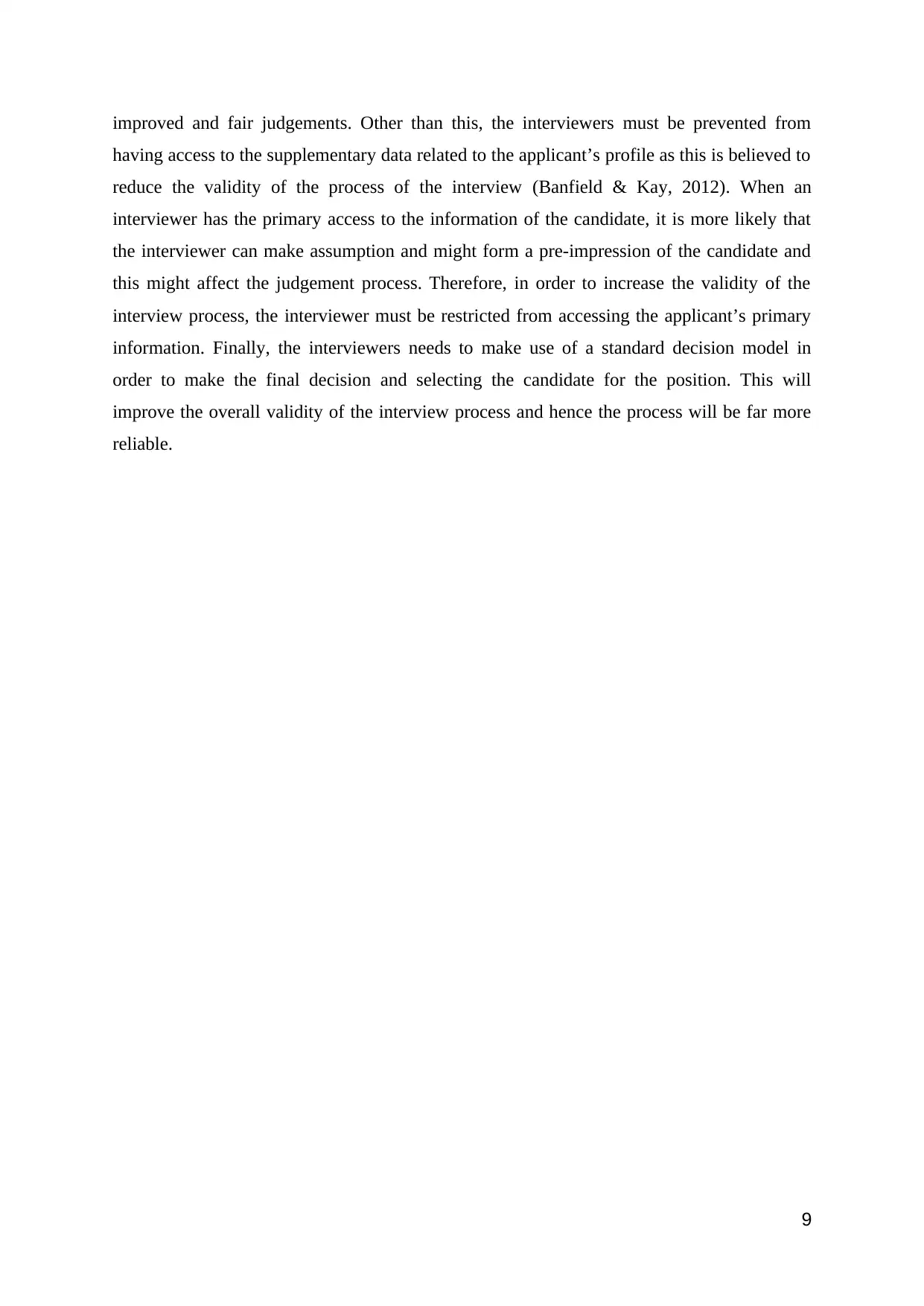
improved and fair judgements. Other than this, the interviewers must be prevented from
having access to the supplementary data related to the applicant’s profile as this is believed to
reduce the validity of the process of the interview (Banfield & Kay, 2012). When an
interviewer has the primary access to the information of the candidate, it is more likely that
the interviewer can make assumption and might form a pre-impression of the candidate and
this might affect the judgement process. Therefore, in order to increase the validity of the
interview process, the interviewer must be restricted from accessing the applicant’s primary
information. Finally, the interviewers needs to make use of a standard decision model in
order to make the final decision and selecting the candidate for the position. This will
improve the overall validity of the interview process and hence the process will be far more
reliable.
9
having access to the supplementary data related to the applicant’s profile as this is believed to
reduce the validity of the process of the interview (Banfield & Kay, 2012). When an
interviewer has the primary access to the information of the candidate, it is more likely that
the interviewer can make assumption and might form a pre-impression of the candidate and
this might affect the judgement process. Therefore, in order to increase the validity of the
interview process, the interviewer must be restricted from accessing the applicant’s primary
information. Finally, the interviewers needs to make use of a standard decision model in
order to make the final decision and selecting the candidate for the position. This will
improve the overall validity of the interview process and hence the process will be far more
reliable.
9
⊘ This is a preview!⊘
Do you want full access?
Subscribe today to unlock all pages.

Trusted by 1+ million students worldwide
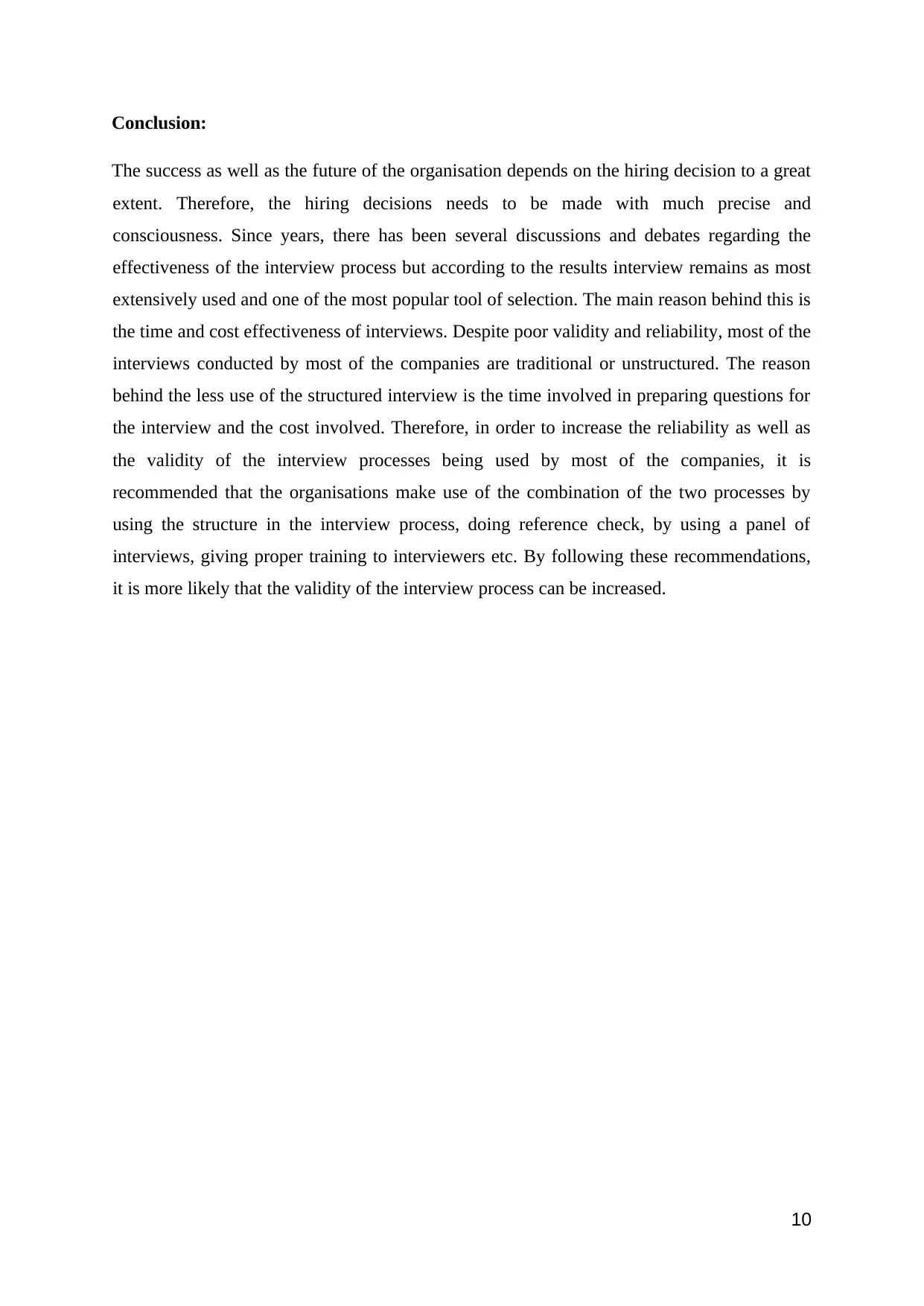
Conclusion:
The success as well as the future of the organisation depends on the hiring decision to a great
extent. Therefore, the hiring decisions needs to be made with much precise and
consciousness. Since years, there has been several discussions and debates regarding the
effectiveness of the interview process but according to the results interview remains as most
extensively used and one of the most popular tool of selection. The main reason behind this is
the time and cost effectiveness of interviews. Despite poor validity and reliability, most of the
interviews conducted by most of the companies are traditional or unstructured. The reason
behind the less use of the structured interview is the time involved in preparing questions for
the interview and the cost involved. Therefore, in order to increase the reliability as well as
the validity of the interview processes being used by most of the companies, it is
recommended that the organisations make use of the combination of the two processes by
using the structure in the interview process, doing reference check, by using a panel of
interviews, giving proper training to interviewers etc. By following these recommendations,
it is more likely that the validity of the interview process can be increased.
10
The success as well as the future of the organisation depends on the hiring decision to a great
extent. Therefore, the hiring decisions needs to be made with much precise and
consciousness. Since years, there has been several discussions and debates regarding the
effectiveness of the interview process but according to the results interview remains as most
extensively used and one of the most popular tool of selection. The main reason behind this is
the time and cost effectiveness of interviews. Despite poor validity and reliability, most of the
interviews conducted by most of the companies are traditional or unstructured. The reason
behind the less use of the structured interview is the time involved in preparing questions for
the interview and the cost involved. Therefore, in order to increase the reliability as well as
the validity of the interview processes being used by most of the companies, it is
recommended that the organisations make use of the combination of the two processes by
using the structure in the interview process, doing reference check, by using a panel of
interviews, giving proper training to interviewers etc. By following these recommendations,
it is more likely that the validity of the interview process can be increased.
10
Paraphrase This Document
Need a fresh take? Get an instant paraphrase of this document with our AI Paraphraser

References
Banfield, P. & Kay, R., 2012. Introduction to Human Resource Management.
s.l.:Oxford University Press.
Brewster, C., Sparrow, P., Vernon, G. & Houldsworth, E., 2011. International Human
Resource Management. London: CIPD.
Carberry, C. & Cross, C., 2015. Human Resource Development: A Concise
Introduction. London: Palgrave.
Gilmore, S. & Williams, S., 2013. Human Resource Management. s.l.:Oxford
University Press.
HRMP, 2019. Effectiveness of Interviews. [Online]
Available at: http://hrmpractice.com/effectiveness-of-interviews/
Lunn, E. & Sarsby, A., 2015. A project leader's guide to recruitment and selection.
s.l.:Lulu.com.
Mankin, D., 2009. Human Resource Development. s.l.:Oxford University Press.
Mcdaniel, M. A., Whetzal, D., Schimdt, F. L. & Mourer, S. D., 2014. The validity of
employment interviews: A comprehensive review and meta-analysis. The Journal of
Applied Psychology, 79(4), pp. 599-616.
Mello, J. A., 2015. Strategic Human Resource Management. Stamford: Cengage.
Picardi, C. A., 2019. Recruitment and Selection: Strategies for Workforce Planning
and Assessment. s.l.:SAGE Publications.
Rees, G. & Smith, P., 2014. Strategic Human Resource Management: An
International Perspective. s.l.:Sage Publications.
11
Banfield, P. & Kay, R., 2012. Introduction to Human Resource Management.
s.l.:Oxford University Press.
Brewster, C., Sparrow, P., Vernon, G. & Houldsworth, E., 2011. International Human
Resource Management. London: CIPD.
Carberry, C. & Cross, C., 2015. Human Resource Development: A Concise
Introduction. London: Palgrave.
Gilmore, S. & Williams, S., 2013. Human Resource Management. s.l.:Oxford
University Press.
HRMP, 2019. Effectiveness of Interviews. [Online]
Available at: http://hrmpractice.com/effectiveness-of-interviews/
Lunn, E. & Sarsby, A., 2015. A project leader's guide to recruitment and selection.
s.l.:Lulu.com.
Mankin, D., 2009. Human Resource Development. s.l.:Oxford University Press.
Mcdaniel, M. A., Whetzal, D., Schimdt, F. L. & Mourer, S. D., 2014. The validity of
employment interviews: A comprehensive review and meta-analysis. The Journal of
Applied Psychology, 79(4), pp. 599-616.
Mello, J. A., 2015. Strategic Human Resource Management. Stamford: Cengage.
Picardi, C. A., 2019. Recruitment and Selection: Strategies for Workforce Planning
and Assessment. s.l.:SAGE Publications.
Rees, G. & Smith, P., 2014. Strategic Human Resource Management: An
International Perspective. s.l.:Sage Publications.
11
1 out of 11
Related Documents
Your All-in-One AI-Powered Toolkit for Academic Success.
+13062052269
info@desklib.com
Available 24*7 on WhatsApp / Email
![[object Object]](/_next/static/media/star-bottom.7253800d.svg)
Unlock your academic potential
Copyright © 2020–2025 A2Z Services. All Rights Reserved. Developed and managed by ZUCOL.





